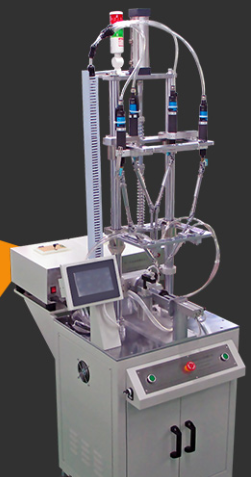What are the common electrical faults and solutions for brushless motor motor automatic lock screw machine?
Brushless motor motor automatic locking screw machine common electrical faults and solutions are as follows:
First, power-related failures
1, the machine can not start
l Failure to perform: press the start button, the screwdriver does not have any response, the display does not light up, the motor does not run.
l Reason for failure:
The power plug is loose or the power cord is damaged.
The power switch is damaged.
The fuse is blown.
Power module failure.
l Solution:
Check whether the power plug is plugged in properly, if the power cord is damaged, you need to replace it with a new one.
Use a multimeter to detect the on-off situation of the power switch, and replace it if it is damaged.
Check the fuse, if it is blown, check whether there is a short circuit or other problems in the circuit, and then replace the fuse with the same specifications.
Detect the output voltage of the power module, if abnormal, you need to contact the manufacturer to repair or replace the power module.

2, voltage instability
l Failure to perform: lock the screw machine work abnormally, such as motor speed suddenly fast and slow, the display is abnormal.
l Failure causes:
Grid voltage fluctuation.
Power filter failure.
Power module internal components aging.
l Solution:
Install a voltage regulator to stabilize the input voltage.
Check the power filter and replace it if it is faulty.
If the power module components are aging, you need to contact a professional to repair or replace the module.
Second, the motor drive failure
1, the motor does not rotate
l Failure performance: After starting the screw locking machine, the motor does not have any action.
l Fault cause:
Motor drive board failure.
The motor winding is short-circuited or broken.
The connection line between the motor and the driving board is loose or damaged.
The controller does not output the correct drive signal.
l Solution:
Detect whether the components on the driver board are damaged, such as power tubes, capacitors, etc., and replace them if they are damaged.
Use a multimeter to measure the resistance of the motor winding to determine whether it is short-circuited or disconnected, and replace the motor if there is any problem.
Check the connection line to make sure it is firmly connected, and replace it if it is damaged.
Check the settings and output signals of the controller, if there is any problem, reset or repair the controller.
2、Abnormal motor speed
l Failure performance: the motor speed is too fast or too slow to reach the set speed.
l Failure causes:
The motor drive parameters are set incorrectly.
The potentiometer on the drive board is damaged or improperly adjusted.
Motor load is too large.
Encoder fault (if encoder is used).
l Solution:
Reset the motor drive parameters to match the specifications of the motor.
Check the potentiometer and replace it if it is damaged, or re-adjust it if it is improperly adjusted.
Check the working load of the screw locking machine and eliminate the overload factor.
Detect the working condition of the encoder, and replace it if it is faulty.
Third, the sensor failure
1, screw detection sensor failure
l Failure performance: unable to correctly detect the presence or absence of screws, resulting in leakage or repeated locking screws.
l Failure causes:
Sensor installation position offset.
The sensor surface is covered with dust or debris.
The sensor is damaged.
The sensor's connection line is loose or damaged.
l Solution:
Readjust the mounting position of the sensor so that it can accurately detect the screws.
Clean the sensor surface to ensure that there is no dust and debris.
Use a tool such as a multimeter to detect the output signal of the sensor, and replace the sensor if it is damaged.
Check the connection line to ensure a firm connection, and replace it if the line is damaged.
2, position sensor failure
l Failure performance: The actuator of the screw-locking machine can not accurately reach the specified position, resulting in inaccurate screwing position.
l Reason for failure:
The sensor is loosely installed or the position is changed.
The detection distance of the sensor is not suitable.
The internal components of the sensor are damaged.
l Solution:
Tighten the mounting screws of the sensor and adjust its position so that it can accurately detect the position.
Adjust the detection distance of the sensor so that it meets the requirements.
If the internal components of the sensor is damaged, the sensor needs to be replaced.
Fourth, the controller failure
1, the program running error
l Failure performance: the running program of the screw locking machine appears to be chaotic, such as the execution of the wrong action, skipping some steps, etc..
l Failure causes:
The controller program is disturbed or damaged.
The memory of the controller is faulty.
The input and output interfaces of the controller are damaged.
l Solution:
Redownload or update the controller program.
Check the memory of the controller and repair or replace it if it is faulty.
Detect the working condition of the input and output interfaces, and replace them if they are damaged.
2, communication failure
l Failure to perform: lock screw machine and the host computer or other devices can not be normal communication between the data transmission failure.
l Failure causes:
The communication line is connected incorrectly or loose.
Incorrect communication protocol settings.
Communication module failure.
l Solution:
Check the communication line to ensure that it is connected correctly and firmly, and replace it if it is damaged.
Reset the communication protocol to match the connected device.
Check the working condition of the communication module and replace it if it is faulty.
※ If the above ways and means still can not solve the equipment failure, please contact Xinhui Electromechanical Equipment Company Limited technical specialists through the page chat tool to seek help.







